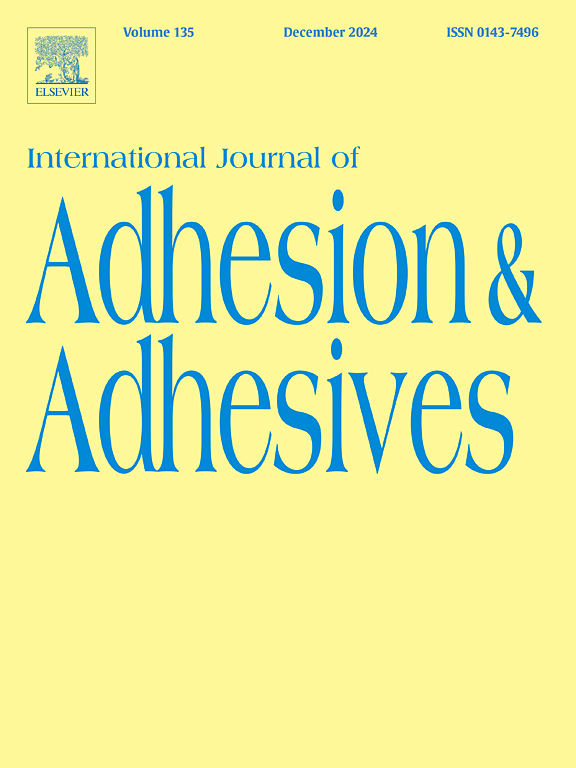Zinc zeolite nanoparticle-modified adhesive resin: Influence on dentin matrix degradation and bond strength to dentin
IF 3.2
3区 材料科学
Q2 ENGINEERING, CHEMICAL
International Journal of Adhesion and Adhesives
Pub Date : 2024-11-15
DOI:10.1016/j.ijadhadh.2024.103890
引用次数: 0
Abstract
Purpose
Endogenous dentin enzymes degrade collagen fibrils in the restoration-dentin interface. Zinc has been identified as a potential enhancer of adhesive interface stability of adhesive interface by inhibiting enzymatic activity. The present study aimed to investigate the degradation resistance of adhesive interfaces created by a resin adhesive containing zinc zeolite nanoparticles.
Materials and methods
Dentin beams (1 mm x 2 mm x 6 mm), completely demineralized in 0.5 M EDTA and treated with 10 % phosphoric acid for 15 min (control), were immersed in experimental resin (40 % bis-GMA, 30 % TCDM, 28.75 % TEGDMA, and 1 % EDMAB) modified with 0, 2, 5 and 10 wt% zinc zeolite nanoparticles for 2 h. Each beam was then incubated in artificial saliva medium for 1, 3, 7, 14 and 30 days, with dry mass loss measured at each time-point. Hydroxyproline and CTX contents were analyzed in the incubation medium. Zinc release from zinc zeolite-containing resin disks was measured with atomic emission spectroscopy. The microtensile bond strength (μTBS) of zinc zeolite-modified adhesive resin (All Bond Universal, Bisco Inc.) to dentin was also tested. The data were analyzed using repeated measures of ANOVA, and ANOVA and post-hoc Tukey HSD tests at p = 0.05.
Results
Zinc zeolite at 10 wt% showed higher mass loss at all time-points, except on the 1-day (p < 0.05). No significant difference was found in hydroxyproline contents of the incubation medium (p > 0.05), however, the CTX quantity was higher in the zinc zeolite 10 % group (p < 0.05). Zinc release was confirmed for zeolite groups, reaching the maximum level at the 7 days of incubation. Zinc zeolite at 10 wt% resulted in significantly lower μTBS (p < 0.05).
Conclusions
Zeolite nanoparticles incorporated in dentin adhesives may serve as ion reservoirs. However, zinc content of zeolite particles should be adjusted according to the optimum levels for the inhibition of dentin enzymes.
锌沸石纳米颗粒改性粘合树脂:对牙本质基质降解和牙本质粘接强度的影响
目的内源性牙本质酶会降解修复体-牙本质界面中的胶原纤维。锌可抑制酶的活性,从而增强粘接界面的稳定性。本研究旨在探讨含有锌沸石纳米粒子的树脂粘合剂所形成的粘合界面的抗降解性。然后将每根横梁在人工唾液培养基中培养 1、3、7、14 和 30 天,在每个时间点测量干质量损失。对培养基中的羟脯氨酸和 CTX 含量进行了分析。用原子发射光谱法测定了含锌沸石树脂盘的锌释放量。此外,还测试了锌沸石改性粘合剂树脂(All Bond Universal,Bisco Inc.结果10 wt% 的锌沸石在所有时间点都表现出较高的质量损失,1 天除外(p < 0.05)。培养基中的羟脯氨酸含量无明显差异(p > 0.05),但 10%锌沸石组的 CTX 量更高(p < 0.05)。沸石组的锌释放得到证实,在培养 7 天时达到最大水平。结论牙本质粘合剂中的沸石纳米颗粒可作为离子储库。然而,沸石颗粒中的锌含量应根据抑制牙本质酶的最佳水平进行调整。
本文章由计算机程序翻译,如有差异,请以英文原文为准。
求助全文
约1分钟内获得全文
求助全文
来源期刊

International Journal of Adhesion and Adhesives
工程技术-材料科学:综合
CiteScore
6.90
自引率
8.80%
发文量
200
审稿时长
8.3 months
期刊介绍:
The International Journal of Adhesion and Adhesives draws together the many aspects of the science and technology of adhesive materials, from fundamental research and development work to industrial applications. Subject areas covered include: interfacial interactions, surface chemistry, methods of testing, accumulation of test data on physical and mechanical properties, environmental effects, new adhesive materials, sealants, design of bonded joints, and manufacturing technology.
 求助内容:
求助内容: 应助结果提醒方式:
应助结果提醒方式:


